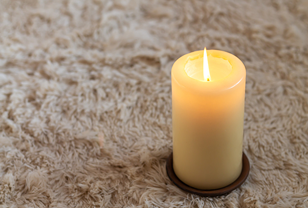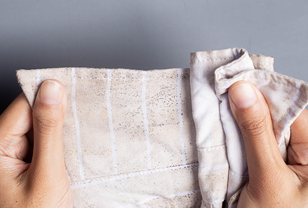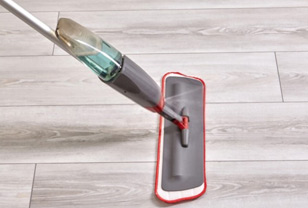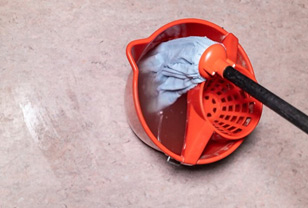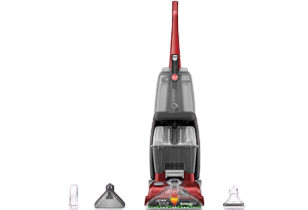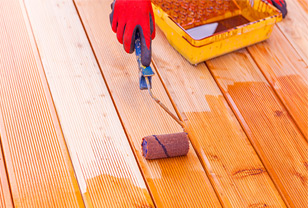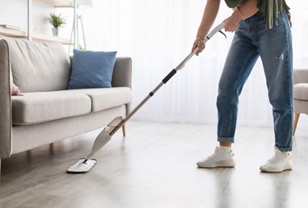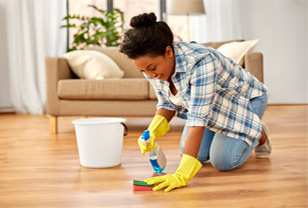How to Repair Swollen Laminate Flooring Without Replacing: DIY Techniques
We can all agree that the cost of new laminate flooring is nowhere near the expensive zone. But it would be a shame to throw away perfectly good laminate flooring to install a new one, given the fact that this flooring type is pretty durable.
Therefore, learning how to repair swollen laminate flooring without replacing it with a new one will not only help you save some extra bucks but also use up your laminate floor potential to the fullest.

A swollen laminate floor definitely does not look appealing at all
If you have a swollen laminate floor at home, this is the right post for you. And even if your laminate floor has not suffered this problem, it is best to know what you can do to prevent this annoying scenario in the future.
In this post, we will get to know three main topics:
- The reasons why your laminate floor becomes swollen.
- How to repair your swollen laminate floor.
- What you can do to prevent laminate flooring from swelling.
At the end of this post, there is an FAQs section to answer what you want to know more about treating swollen laminate flooring.
Let’s get started!
Reasons Why Your Laminate Floor Becomes Swollen
If one day you see unusual swelling or bubbles appear on your laminate floor, it is definitely a sign that something not right is happening to your precious flooring. You will feel like you should act quickly to treat these spots, not letting them spread all over the place.
But to know the correct way to cure a disease, we need to know the cause. It is the same logic as treating a swollen laminate floor.
That is why before learning how to repair your swollen laminate flooring, you should know what causes this annoying problem in the first place. We have listed the most common reasons that damage the perfect appearance of your laminate floor. They are:
1. Moisture
Moisture is the main cause of laminate floor swelling. When too much moisture creeps into your laminate flooring, it will slowly swell because although the laminate floor is water-resistant, it is not completely waterproof.
What happens, in this case, is the water gets underneath the top layers of your laminate floor and soaks into the core layers. It can be caused by a large spill and you did not clean it quickly enough. But it can also happen to a poorly sealed laminate floor.
Another scenario is one of your water pipes underneath the floor is leaking, causing the water to seep into the core layers of your laminate floor. This is the most intense cause that may heavily damage your laminate floor and the swollen surface is only the last symptom.

A leaking water pipe underneath your laminate floor can also be the cause of swelling on the floor’s surface
Excessive wet mopping and steam cleaning over time can also create this problem. So, you also need to be careful with your cleaning plan. Do not overly clean your laminate floor, especially by using a harsh chemical solution because it can peel off the protective layer, which makes it easier for the moisture to enter your laminate flooring core.
2. Incorrect Installation
The laminate floor responds to the temperature changes in your room by expanding when it rises and contracting when it falls. That is why incorrect installation in the first place can create a vulnerable laminate floor that will easily form peaking, bubbles, and it might even buckle.
Not only does the laminate floor need to be installed in a specific way to create “expansion gaps” for it to respond to the temperature changes, but it is also recommended that you leave the new laminate planks in the room for at least 72 hours before installation so that it adjusts naturally to the room temperature, which helps it to be more stable in the future.
Therefore, people who install their laminate floors at home have a higher chance of damaging their floors and making them swollen later on. Although it is not necessary to hire professionals to install the laminate floor for you, it is essential to research the topic beforehand if you plan to do it as a DIY project.
3. Trapped Air
When your laminate flooring is not properly ventilated, the excess air has nowhere to go, that is why it will eventually start to bubble up through the laminate floor’s surface.
The cause of this problem is improper laminate flooring installation at the beginning. But it can also happen to damaged laminate flooring because there is an open space that can let the air travel through and be trapped inside the surface, which later on tries to escape and make your laminate floor swollen.
Now that you know the main reasons that cause swelling in your laminate floor, let us learn about the methods to deal with this problem.
How to Repair Your Swollen Laminate Floor
Once you see bubbles and swelling appear on your laminate floor surface, you should try to find the cause of the problem. And the sooner you treat your laminate floor, the better you prevent this problem from spreading and becoming more serious.
For minor laminate flooring swelling, the methods we are going to introduce to you below can quickly make them disappear. You can try to get rid of those ugly defects and restore the beautiful and flawless flooring surface.
But remember, although we will teach you how to repair swollen laminate flooring without replacing it, if the damage is too heavy, we recommend that you rip off the old laminate floor and install a new one.
1. Using Heat
You can perform this method with a hair dryer or a heater. But you should note that this method is not effective with bubbles on the laminate floor.

You can use a hair dryer to treat your swollen laminate floor
Once you find that there is moisture underneath your laminate floor, use a hair dryer or a heater to evaporate it as soon as possible. If you resolve this problem fast enough, the moisture will not damage the laminate floor further and the bubbles will not form.
Be careful not to burn yourself or leave burn marks on your laminate floor during the process. Although we need to do this as quickly as we can, we should not take the risk of creating further damage to the laminate floor.
2. Bursting the Minor Bubbles
If there are some minor bubbles on your laminate floor, you can try bursting them and packing the floor back yourself. What you will need is a knife, a damp cloth, and some wood glue.
First, dampen the area that has bubbles with the damp cloth. We know how many times we have talked about moisture creating swollen laminate floors, but this step is necessary to treat the bubble. In fact, the spot is already damaged so we should fix it first.
Next, use a knife to poke a tiny incision on the bubble. Do not flatten the bubble at this point yet. We need to stick the affected area down for good so there is one step we need to do beforehand, which is to inject the right amount of wood glue into the incision.
Finally, try to flatten the bubble by slowly smoothening it in one direction towards the incision. If there is excess glue flowing out, wipe it away with a damp cloth. Press the affected area for a while for the glue to hold. If necessary, find a heavy object to weigh it down for a while.
After bursting all the bubbles, leave the laminate floor to rest for at least 12 hours before walking on it again. With a bit of luck, you will not remember the bubbles were there because they have disappeared completely.
3. Using a Roller
If the swollen laminate floor is caused by trapped air, you can try to flatten it out by using a roller. Take note that not all rollers are suitable for this method. You should pick up a 100 lbs roller from a hardware store, or you will need to put a lot of pressure during the process.
This method can restore the laminate floor back to its original state, but keep in mind that it does not deal with the core reason, so there will be a time when the bubbles rise again. It is best to find a way to release the trapped air, and you can learn how to seal laminate flooring to prevent this problem from happening again in the future.
4. Replace a Single Laminate Plank
You do not have to replace the whole laminate floor if the damage only appears on a certain surface area. Replacing one or some laminate planks is a better choice in this scenario, which costs less than replacing the whole floor and creates the best result compared to the three methods above.

You can replace only damaged planks instead of the whole laminate floor
To perform this method, you need to check how many new planks you need to purchase based on the damage on your laminate floor. Then, you can start to remove the old planks and install the new ones after leaving them in the room for at least 72 hours so that they can adapt to the temperature.
We recommend that you look for a tutorial on removing and installing laminate floors if you plan to do it yourself. Otherwise, it never hurts to hire a professional to do the replacement for you if money is not a problem and that it matters more than having a swollen laminate floor in your opinion.
What You Can Do to Prevent Laminate Flooring from Swelling
No matter whether your laminate floor has swollen or not, it is best to notice these things to prevent this problem later on:
- Do proper laminate floor installation in the first place.
- Do not over-clean your laminate floor, especially with water, steam, and harsh chemical solutions.
- Check your plumbing every once in a while to make sure there is no leakage underneath the laminate floor.
- Treat minor bubbles and swelling right away and have your laminate floor checked to prevent the problem from becoming more serious.
Conclusion
We hope that after reading this post, you have better knowledge about why your laminate floor is swollen and how to repair swollen laminate flooring without replacing it.
Keep in mind that these methods are only good for minor damage. If the problem is too serious which affects the quality of the laminate floor, the best thing you can do is install new flooring.
FREQUENTLY ASKED QUESTIONS
- 01. Do vinyl floors suffer from swelling like laminate floors?
-
If you are thinking of using a vinyl floor to prevent the swelling problem that the laminate flooring has, then we are sorry to inform you that it will not work. Since the difference between vinyl and laminate flooring is not much, swelling and bubbles can still happen to the vinyl floor as well.
With that being said, you need to treat the vinyl floor like how we treat the laminate floor in the post to prevent the problem from happening.
- 02. Is it possible to leave the swollen area and continue using the old laminate floor?
-
If you are not bothered with the unsightly swelling on your laminate floor, it is possible to continue using the laminate floor. But keep in mind that once you see more and more bubbles and swelling, it is a sign that your laminate floor is under heavy damage and needs to be replaced sooner or later.
- 03. What is the best time to replace a swollen laminate floor with a new one?
-
If you see the swelling getting worse and the bubbles seem to spread in a short period of time, chances are your laminate floor has greatly deteriorated. You should inspect it right away and replace the damaged floor as soon as possible.
- 04. If the swollen laminate floor is not treated, will it become worse over time?
-
It depends on the main problem. If the cause is something mild and the swelling and bubbles do not appear more over time, then your laminate floor is fine. But in the opposite scenario, it is a sign that you should check and treat your laminate floor right away.
- 05. Do the bubbles and swelling reduce the quality of the laminate floor?
-
In most cases, these damages only affect the appearance of your laminate floor. However, when you see too much swelling and bubbles on your laminate floor, it means something is damaging the core layers and it definitely reduces the quality of the laminate floor.


